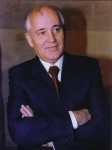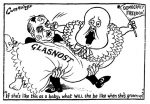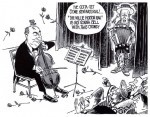
Glasnost and perestroika were the names of significant reforms introduced by Soviet leader Mikhail Gorbachev in the 1980s. These reforms followed a dismal decade in the Soviet Union, due to economic stagnation, falling production, significant shortages and a marked decline in living standards. Gorbachev was elected General Secretary of the Communist Party chiefly to push through economic reforms that would end stagnation. Younger and less conservative than his predecessors Brezhnev, Andropov and Chernenko, Gorbachev had a strong record of improving economic outcomes at local and regional levels. He was also a skilful negotiator who many hoped could push reform through the Soviet political establishment. Gorbachev’s maiden speech paid tribute to his predecessors and maintained his commitment to communism – but also hinted at a reformist agenda. The Soviet Union needed “a decisive turn in transferring the national economy to the tracks of intensive development”, Gorbachev told listeners. He also stressed the need for better living conditions for Soviet workers, calling for a “qualitative improvement of the material conditions of his life and work, of his spiritual makeup”.
Gorbachev began planning a course for reform and discussing them in high-level party meetings. Shortly after taking office he emphasised the need for uskoreniye (‘accelerated development’) to modernise the economy and improve efficiency and productivity. In a forceful speech in May 1985, Gorbachev called for a minimum annual growth of four percent – but emphasised that this would require changes, some of which would be unpopular. “Those who do not intend to adjust and who are an obstacle to solving these new tasks”, he added “must simply get out of the way”. Understanding that meaningful economic change was impossible under the current regime, Gorbachev sought to modify the Soviet state and its stranglehold over the economy. At the 27th Congress of the Communist Party in February-March 1986, the new Soviet leader floated the need for perestroika or ‘restructuring’. Then a general idea rather than a fully worked-out plan, perestroika called for significant decentralisation of Soviet economic policy and production. Economic recovery was not possible, Gorbachev argued, with the current level of centralised planning and bureaucratic control.

The first two years of Gorbachev’s rule were spent building support for perestroika and removing political obstacles to reform. This was a difficult task, given that the Soviet bureaucracy and Communist Party were populated with conservatives and communist hardliners. This faction was resistant to any policy that looked like a retreating step towards capitalism. In early 1987 Gorbachev gave a fuller account of his ideas in a book titled Perestroika: New Thinking for Our Country and the World. He affirmed his commitment to communism but emphasised the need for greater trust in the people. The Soviet Union, Gorbachev wrote, needed “wholesome, full-blooded functioning by all public organisations, all production teams and creative unions, new forms of activity by citizens and the revival of those which have been forgotten. In short, we need broad democratisation of all aspects of society. That democratisation is also the main guarantee that the current processes are irreversible… We want to invigorate the human factor.”
As mentioned above, perestroika sought to revive economic production by weakening Moscow’s centralised stranglehold. By 1987 Gorbachev had enough support to push through a law allowing factories and manufacturers to determine their own output, effectively ending production quotas. These industries were now able to adopt some practices used by private businesses: setting production levels, sourcing materials, paying expenses and wages, even selling surplus goods. The main difference was that Soviet firms were controlled by workers’ collectives rather than private owners. These changes did little to improve the ailing Soviet economy so Gorbachev became even more ambitious. Identifying a need for capital investment, Gorbachev permitted foreign companies to invest in the Soviet economy (June 1987), so long as this investment took the form of joint ventures and majority ownership remained in Soviet hands. More reforms in May 1988 legalised the private ownership of most businesses, as well as removing barriers to foreign trade.
“Gorbachev has sought to redistribute power and privilege in the Soviet Union. He has been trying to effect a revolution from above and below. His main target has been the state and party bureaucracy. By reducing its decision-making functions, enterprises and cooperatives and individual producers gain greater control over their activities. [But] Gorbachev had to admit that, after four years, restructuring had not brought any tangible improvements. How long could the great experiment last before patience was exhausted?”
Martin McCauley, historian
These economic reforms were accompanied by some political liberalisation and demokratizatsiia (‘democratisation’). Frustrated by opposition from within the Communist Party, Gorbachev floated constitutional changes to weaken the party’s grip on government and policy. His most significant change was the creation of a new national parliament. The Congress of People’s Deputies, as the new body was called, was floated in July 1988. Nominations for candidates became open and competitive, allowing Soviet citizens to select their own representatives rather than having them appointed by the party. This marked the end of the one-party state, as other non-communist parties were allowed to stand candidates. In elections for the Congress of People’s Deputies in early 1989, around 300 reformist candidates were elected and many ‘old communists’ were removed from the government. One of those to depart was Andrei Gromyko, who had served as the Soviet Union’s foreign minister for a staggering 38 years. Gorbachev himself was elected Chairman of the Supreme Soviet, extending his constitutional power. While these changes left the Soviet Union far from democratic, they encouraged greater levels of political participation and freedom.

The second aspect of Gorbachev’s reforms was dubbed glasnost (Russian for ‘openness’). Glasnost lifted restrictions on information and debate that had been a feature of Soviet life since the days of Joseph Stalin. Under glasnost, media censorship was relaxed, though not completely abolished. Literature previously banned in the USSR was now permitted. The horrors of the Stalinist regime, once suppressed and whispered about in private, were exposed and openly discussed. The policy failures of previous leaders were also subjected to scrutiny and criticism. Privately, Gorbachev hoped that lifting censorship would expose the errors of previous governments, creating support for more extensive economic reforms. Many Soviet people believed they were living in a successful communist state; under glasnost, they began to understand how dismal their lives were in comparison to those in the West. Glasnost reforms also encouraged greater political involvement and accessibility. In 1989 viewers tuned in to live broadcasts from the Congress of People’s Deputies, meeting for the first time with democratically-elected members. They were astonished to see deputies criticising leaders past and present, the government, bureaucracy, the Soviet military hierarchy, even the much-feared KGB.

Perestroika and glasnost marked a genuine attempt to revive the Soviet Union by creating a mixed economy and a freer society. Today, these changes are widely considered to have failed. There were a number of reasons for this. Many experts believe Gorbachev’s economic reforms did not follow a complete plan but were attempted gradually and experimentally. Some believe these reforms did not go far enough: they left too much economic control in the hands of the Soviet bureaucracy, such as the power to fix prices, regulate foreign exchange and manage raw materials and resources. The reforms were also hindered by widespread internal opposition. Elements in the Soviet bureaucracy, which was responsible for implementing the reforms, were stridently opposed to them. The Soviet economic system was fundamentally flawed and needed to be replaced, not reformed; Gorbachev’s piecemeal changes were not enough to revive the economy – and indeed only created confusion and disruption. These critical economic problems, coupled with the changing political landscape in 1989-91, contributed to the dissolution of the Soviet Union and the end of the Cold War.

1. The 1970s and 1980s were a miserable period for most Soviet citizens, who endured chronic economic stagnation, severe food and commodity shortages and the occupation of Afghanistan.
2. After gaining power in March 1985, Gorbachev accounted two reformist polices to revive the Soviet economy. He called them glasnost (‘openness’) and perestroika (‘restructuring’).
3. Perestroika aimed to revive the economy through decentralisation, weakening the power of Soviet central planners and allowing more local decision-making and some private ownership.
4. The glasnost reforms led to a relaxation in censorship and some political liberalisation, which increased public debate, criticism and nationalism in the Soviet republics.
5. Gorbachev’s reforms failed for several reasons. There was widespread opposition to them within the Soviet bureaucracy. The reforms were also too gradual and piecemeal and failed to revive an economy that needed more radical reform and fundamental change.

Gorbachev’s maiden speech hints at economic reform (March 1985)
Content on this page is © Alpha History 2018. This content may not be republished or distributed without permission. For more information please refer to our Terms of Use.
This page was written by Jennifer Llewellyn and Steve Thompson. To reference this page, use the following citation:
J. Llewellyn & S. Thompson, “Glasnost and perestroika“, Alpha History, accessed [today’s date], https://alphahistory.com/coldwar/glasnost-and-perestroika/.
